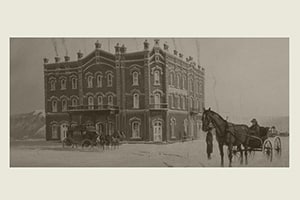Montana has an expansive land mass and a wild-west history to match. As the 4th largest state in our union the scenery transforms from its eastern plains into vast mountain ranges as one travels westward. Nicknamed “Big Sky Country” for its sweeping views, it is also nicknamed the “Treasure State” due to the state’s resources in it gold, silver, copper, oil and coal. Early settlers were attracted to its mining and agricultural opportunities. Conflicts and battles arose when native American Indians were encroached upon by white settlers. The Homestead Act of 1862 further solidified the white man’s presence offering free land to settlers if they indeed “up proved” 160 allotted acres. This was a challenging feat in the arid climate. Soon the railroad made its appearance. Today Montana is still considered a frontier land as the country’s least populated state with the average of 6 people per square mile.
Fort Benton, referred to as “the birthplace of Montana”, it is one of the oldest settlements in the American West. As one of the most important ports on the Missouri-Mississippi river system it was part of the overland link of trade between the Missouri and Columbia Rivers. Along this stretch Lewis and Clark traveled on steamboats from St. Louis. During this time William H. Todd had a vision of creating a luxury hotel in this gateway location streaming with travelers as they arrived ready to embark on frontier life. It is here that a charming hotel, The Grand Union Hotel was built on the wooded banks of the Missouri River. Labeled as one of the oldest hotels in Montana today, it has weathered many economic struggles and has gone from a grand hotel to a flop hotel and back; today it is still in operation, and has been elegantly restored to its 1882 grand splendor. The hotel offers 27 luxurious rooms, elegant riverside dining and historic western ambiance. On-site riverside dining can be enjoyed June thru August. A long summer evening can be spent sipping a cold beverage at the Grand Union Saloon reminiscing of the days of the old West.
In southwest Montana, the historic Sacajawea Hotel was established in 1882 as a private residence in Three Forks. Mr. John Q. Adams, purchasing agent for the Milwaukee Railroad requested a hotel to service train crew and passengers for the railroad stop. The original Madison house was moved by a horse team to its current location and the remainder of the building was constructed in 1910. The hotel was named after Sacajawea a famous guide, interpreter and peaceful presence that helped the Lewis and Clark Expedition. She was Shoshone born into the Shoshone tribe which had camped in the area of Three Forks. Sacajawea was kidnapped as a child only a mile or so from where the hotel was placed.
Having survived many hardships through the years this iconic Montana inn has its share of ghost stories ranging from John Q. Adams himself lurking in the hallways to a ghostly maid that visits upon occasion. Recently the hotel received the Historic Preservation Award of Excellence. With its 29 luxury guest rooms, two full service bars, delicious fine dining restaurant, original fixtures and a portrait of Sacajawea in the lobby make it a must see destination for travelers.
Also in southwest Montana, nestled in the town of Livingston, another delightful historic hotel should not be overlooked. The Murray Hotel, referred to as a railroad hotel, it originally went by the name The Elite Hotel. Constructed in 1904 at the height of the passenger railroad era it aimed to accommodate a bustling stream of travelers. Located directly across the street from the Northern Pacific Railway depot in Livingston, Montana, its prime location served it well.
It was renamed the Murray Hotel when the Senators family took ownership after the original owners fell into financial hardship. In 1905 the fashionable hand crank elevator was installed and it was the only elevator in town at the time. Originally built as a two story hotel, it expanded to 4 floors and 66 rooms in the 1920s. It holds its share of ghost stories about some of its suites and the basement connected to the old Livingston tunnels. Many famous guests such as Buffalo Bill and Calamity Jane stayed at the hotel.
Today, Livingston holds tight to its old west charm and attracts a wide array of visitors including famous actors, artists and celebrities. Within walking distance of the Murray one can find fine dining, pubs, theaters and art galleries. The hotel has a roof top patio offering sweeping mountain views and the ambiance inside the hotel is elegant with its old west charm. The lobby is lain in marble and rustic décor. The area remains a world class destination spot for outdoor recreationists with its close proximity to Yellowstone National Park, world-class fly fishing rivers, downhill skiing, hunting, hiking, boating and rodeos. The truly western experience has visitors remembering days gone by and keeps them coming back for more.
Next time when you are traveling around the state of Montana take a little extra time at some of the many historic saloons, shops, restaurants and especially hotels situated around the countryside. Ask a local to share some old stories – for they only happened a few generations ago.

